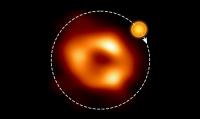New discovery of a black hole in the Milky Way

A still image of the supermassive black hole Sagittarius A* with an artist's illustration indicating where the ALMA data predicts the hot spot to be and its orbit around the black hole, photo: EHT Collaboration, ESO/M. Kornmesser
Scientists have detected a 'hot spot' orbiting Sagittarius A*, the black hole at the centre of our galaxy. The discovery was made by a team led, among others, by Maciej Wielgus, PhD Eng., Polish astronomer and graduate of the Warsaw University of Technology.
Maciej Wielgus, PhD Eng. is a graduate of master's studies in automation and robotics at the Faculty of Mechatronics of the Warsaw University of Technology. In 2016, at the Institute of Micromechanics and Photonics, Faculty of Mechatronics, WUT – he defended his doctoral thesis.
– We think we're looking at a hot bubble of gas zipping around Sagittarius A* on an orbit similar in size to that of the planet Mercury but making a full loop in just around 70 minutes – points out Maciej Wielgus, PhD, Eng. in an interview with PAP – Science in Poland. – This requires a mind-blowing velocity of about 30 percent of the speed of light!
Maciej Wielgus, PhD, Eng. works in the Max Planck Institute for Radio Astronomy in Bonn (Germany). He is a graduate of master's studies in automation and robotics at the Faculty of Mechatronics of the Warsaw University of Technology. In 2016, at the Institute of Micromechanics and Photonics, Faculty of Mechatronics, WUT - he defended his doctoral thesis.
The observations leading to detection a 'hot spot' were made with the Atacama Large Millimeter/submillimeter Array (ALMA) in Chile.
ALMA conducted observations as part of the project called the Event Horizon Telescope (EHT) Collaboration to image black holes. Until now, this has been done for two supermassive black holes: in the M87 galaxy (results were announced in April 2019) and in the centre of the Milky Way (Sagittarius A*), which we were informed in May 2022
Maciej Wielgus, PhD, Eng. and his colleagues used ALMA data to calibrate the EHT data. To their surprise, there were more clues in the ALMA-only measurements. By chance, some of the observations were done shortly after a burst or flare of X-ray energy was emitted from the centre of our galaxy, which was spotted by NASA’s Chandra Space Telescope. Scientists believe that these kinds of flares are associated with so-called ‘hot spots’, hot gas bubbles that orbit very fast and close to the black hole.
According to the Polish astronomer, such flares were so far only clearly present in X-ray and infrared observations of Sagittarius A*. Now we are dealing with radio observations
The research group members think that hot spots observed in both cases are manifestations of the same physical phenomenon. As infrared-emitting hot spots cool down, they become visible at longer wavelengths, i.e. radio waves.
This discovery is a strong evidence for a magnetic origin of these flares. Scientists have already suspected that these flares could come from magnetic interactions in very hot gas very close to Sagittarius A*. The new data will be very helpful in theoretical analyses and give a clue about the geometry of the process
The paper describing the results of the research project „Orbital motion near Sagittarius A∗. Constraints from polarimetric ALMA observations” was appeared in the scientific journal „Astronomy & Astrophysics”.
Source: PAP – Science in Poland







